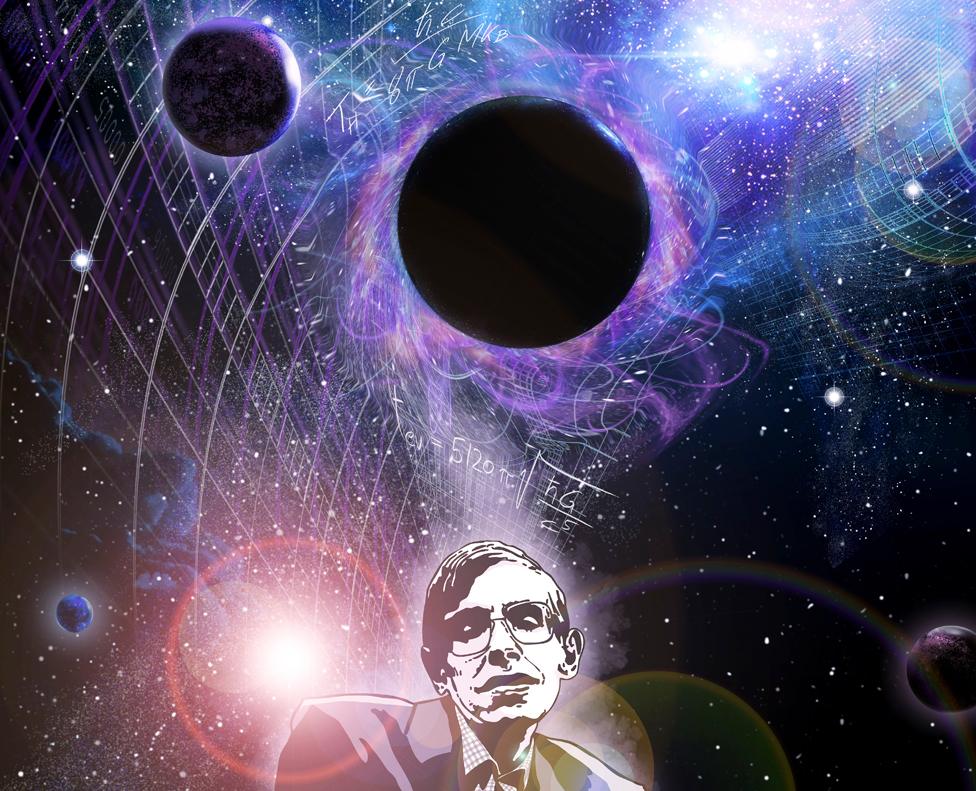Stephen Hawking: The science that made him famous
- Published

Prof Stephen Hawking has died aged 76. The Cambridge theoretical physicist was one of the best-known scientists in the world, but what about his discoveries?
His fame among researchers was founded on a series of studies that wed Albert Einstein's great theory of gravity, general relativity, with the strange world of quantum mechanics, normally applied to tiny things like atoms and molecules.
What Hawking ended up with were descriptions of black holes that could boil themselves out of existence, and equations that described the entire history of the Universe in a single sweep.

Hawking's most important discoveries
With the Oxford mathematician Roger Penrose, he showed that if there was a Big Bang, it must have started from an infinitely small point - a singularity
Black holes radiate energy known as Hawking radiation, while gradually losing mass. This is due to quantum effects near the edge of the black hole, a region called the event horizon
He predicted the existence of mini-black holes at the time of the Big Bang. These tiny black holes would have been incredibly hot, shedding mass until they vanished - potentially ending their lives in a powerful explosion.
In the 70s, Hawking considered whether the particles and light entering a black hole were destroyed if the black hole evaporated. Hawking initially thought this "information" was lost from the Universe. But US physicist Leonard Susskind disagreed. These ideas became known as the information paradox. In 2004, Hawking conceded that the information must be conserved.
With the physicist James Hartle, he tried to describe the history of the cosmos in one mathematical expression. But quantum theory shows that the distinctions between space and time are unclear. As a result, the proposal showed there was little point asking what happened before the Big Bang.

His obsession with black holes
Hawking’s first forays into science publication were as a student in the 1960s when he’d had only the first intimations of the motor neurone disease that would become such a big part of his life.
With Oxford mathematician Roger Penrose, he showed that if there was a Big Bang, it must have started from an infinitely small point - in physicist-speak, a “singularity”.
At the time, when the still cooling afterglow of the Big Bang (the cosmic microwave background radiation) had only just been detected on the sky, other cosmologists had hoped for something less radical than the notion of an entire Universe emerging out of nothing.
Together, Hawking and Penrose showed the quest for gentler answers was hopeless.
Making black holes disappear
Hawking’s next venture, in the 1970s, was to show that black holes are not black at all, but are in fact, as the title of one paper put it, “white hot”.
Black holes are the ultimate monster of general relativity. First conceived and named by John Wheeler, they are regions of space so dense that everything within their realm collapses to a single point – another example of a singularity.
At the time, it seemed ridiculous that these gorgons of gravity should have anything to do with the delicate theory of quantum mechanics, designed to explain light and the orbits of electrons in atoms.

With Roger Penrose, Hawking showed that the Big Bang must have started from an infinitely small point
But Hawking showed otherwise. In fact, quantum theory completely changes the fate of black holes.
At their very fringes, Hawking demonstrated, black holes would create and radiate new particles due to these laws, losing energy, and hence losing mass (remember Einstein's equation E=mc²).
It would take a black hole a very long time to evaporate in this way, but in its last moments Hawking said it would expire in a burst of energy equivalent to a million megaton hydrogen bombs.
When the Large Hadron Collider was opened in the Swiss/French countryside outside Geneva, there was hope that the particle accelerator might be able to create microscopic black holes and so prove Hawking's ideas.
A Nobel Prize would then have been a certainty. But the LHC has seen nothing yet.
An explanation for the Universe
Having tackled single black holes, Hawking turned his attention to the Universe as a whole - the ultimate, inescapable gravitational container.
The laws of quantum science are as applicable here as to a vanishing black hole, especially at the first moment, the Big Bang.
While other researchers struggled to depict a brief moment in the life of a molecule using quantum laws, Hawking showed it was possible to encapsulate the entire history of the whole Universe in a single mathematical expression – “The Wavefunction of the Universe”, as he called it.
Because the expression is self-contained - it starts at a singularity at the beginning of time and is closed by another at the end of time, and if necessary, history can bounce back and forth between these two book ends.
There is no need, indeed no point, to ask what happened before the Big Bang. An existing Universe would explain itself on its own terms.
He wasn't always right
Hawking continued working on the ramifications of this theory to the end of his life.
To know that such a mathematical description might exist is one thing; to know which expression is the right one is a far harder job.
Stephen Hawking’s mind was not the all-conquering juggernaut of public myth.
Like any scientist, he got it wrong from time to time, and often had to concede defeat in intellectual combat.
We sometimes know of this because of his predilection for laying down fanciful bets over debated points – a year’s subscription to Playboy versus one for Private Eye, in one instance.
This happened in 2004, when he conceded to computer scientist John Preskill that black holes were not the ultimate information shredders in the Universe (a consequence he perceived of his black hole theories that would have undermined some of the most fundamental laws of physics).
Hawking accepted black holes could store information about their past, encoded somehow at their edges - the so-called event horizon.
A man for wider horizons
Many researchers were frustrated by the ease with which Stephen Hawking generated publicity, often overshadowing other talents with equally extraordinary or challenging ideas.
His papers were typically at the extremes of mathematical science, a further step along the path he’d chosen to follow in his student days; but they were not always close to the central scientific issues of the day.
Nevertheless, his ability to project his intellectual enthusiasm beyond his frail body, and to draw the wider public into abstruse realms of science is undeniable.